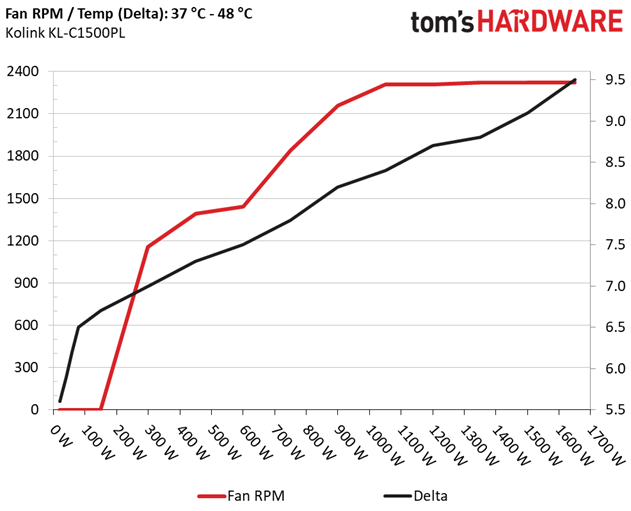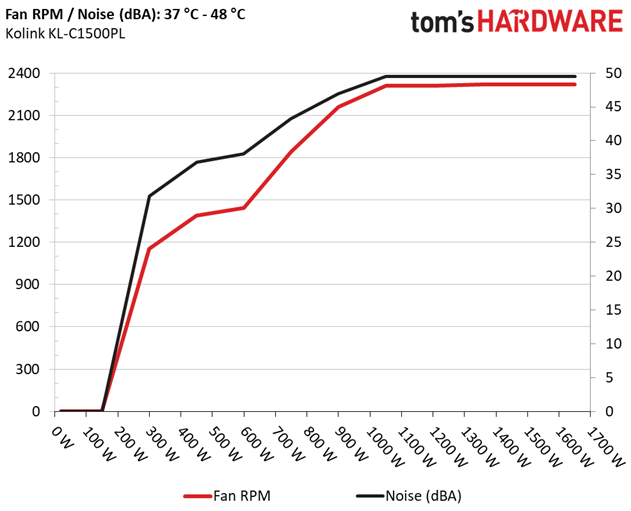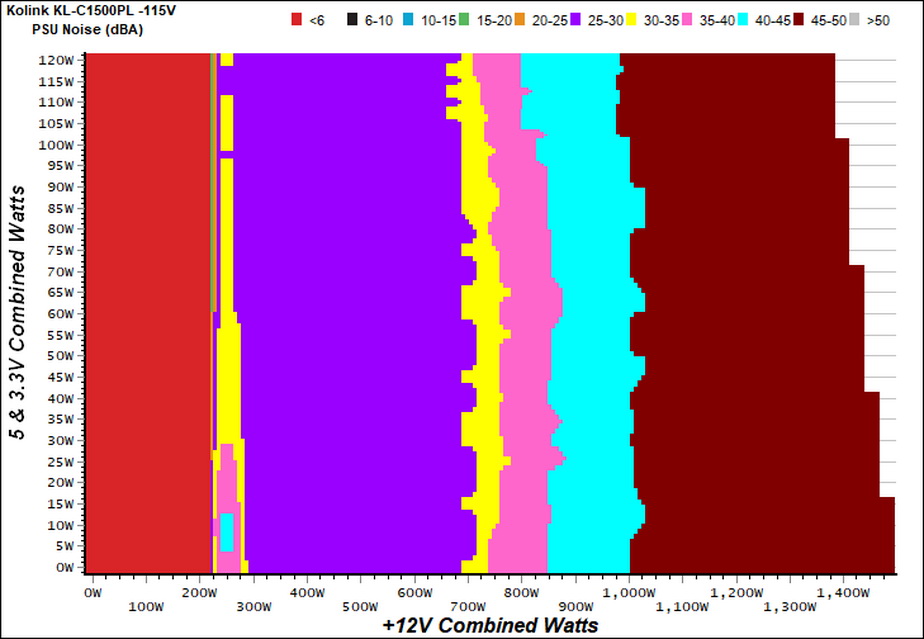Kolink Continuum KL-C1500PL PSU Review: Miner's Delight?
Why you can trust Tom's Hardware
Efficiency, Temperature & Noise
Efficiency
Our efficiency testing procedure is detailed here.
Using results from the previous page, we plotted a chart showing the KL-C1500PL’s efficiency at low loads, and loads from 10 to 110 percent of its maximum-rated capacity.
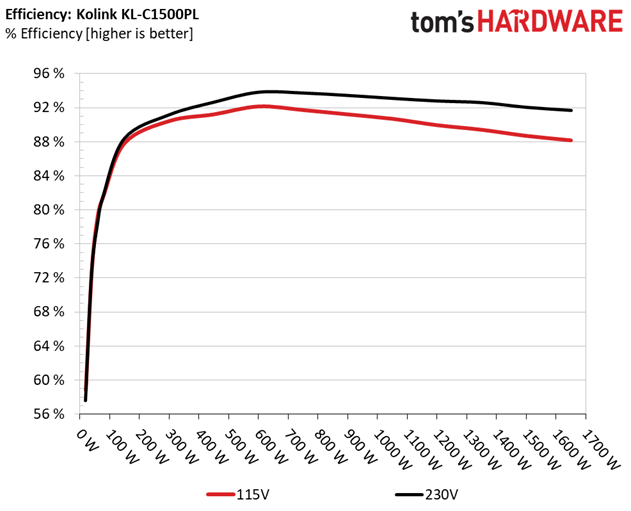
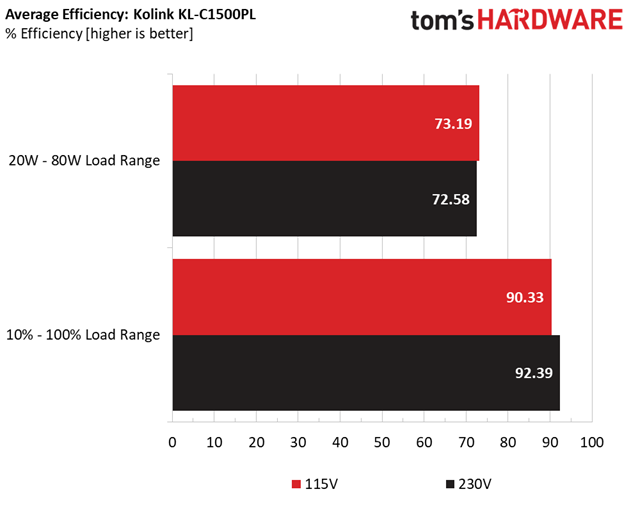
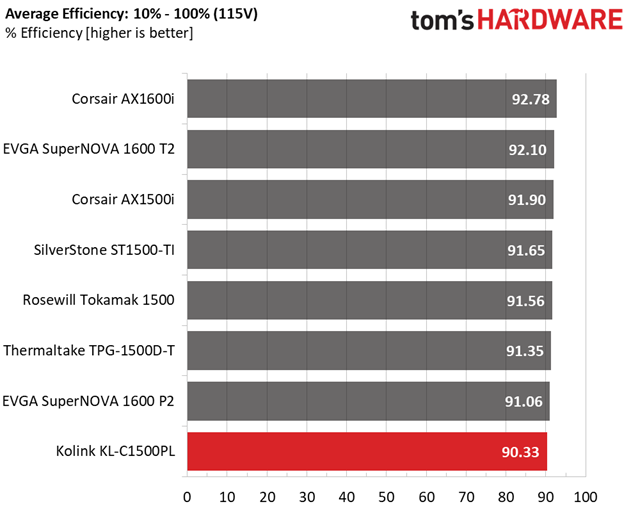
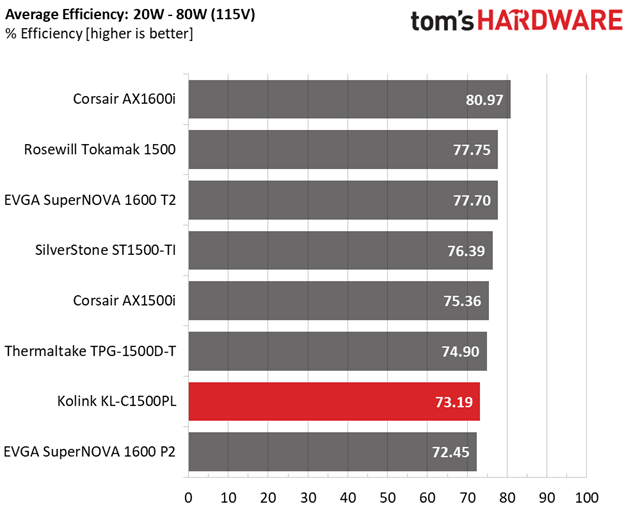
The unit's efficiency looks low compared to EVGA's 1600 P2. However, we'll get a clearer picture once we check the overall efficiency derived from our more detailed cross-load tests.
Competing PSUs in our charts enjoy the benefit of higher efficiency certifications, so we don't exactly have a fair comparison here. Under light loads, the KL-C1500PL beats the 1600 P2. But it lands behind the other power supplies.
Efficiency At Low Loads
In the following tests, we measure the KL-C1500PL's efficiency at loads significantly lower than 10 percent of its maximum capacity (the lowest load the 80 PLUS standard measures). The loads we dialed were 20, 40, 60, and 80W. This is important for representing when a PC is idle, with power-saving features turned on.
| Test # | 12V | 5V | 3.3V | 5VSB | DC/AC (Watts) | Efficiency | Fan Speed (RPM) | PSU Noise | PF/AC Volts |
|---|---|---|---|---|---|---|---|---|---|
| 1 | 1.171A | 0.489A | 0.477A | 0.195A | 19.378 | 58.837% | 0 RPM | <6.0 dB(A) | 0.841 |
| 12.210V | 5.088V | 3.338V | 5.129V | 32.935 | 115.94V | ||||
| 2 | 2.419A | 0.982A | 0.987A | 0.391A | 39.819 | 73.010% | 0 RPM | <6.0 dB(A) | 0.906 |
| 12.208V | 5.086V | 3.334V | 5.121V | 54.539 | 115.91V | ||||
| 3 | 3.598A | 1.474A | 1.469A | 5.111A | 59.308 | 79.177% | 0 RPM | <6.0 dB(A) | 0.954 |
| 12.207V | 5.083V | 3.332V | 5.111V | 74.906 | 115.89V | ||||
| 4 | 4.842A | 1.968A | 1.982A | 0.784A | 79.697 | 81.720% | 0 RPM | <6.0 dB(A) | 0.957 |
| 12.206V | 5.080V | 3.329V | 5.102V | 97.525 | 115.86V |
Under light loads, we observe the low efficiency we'd expect from a PSU with 1.5kW of capacity. It's only with a 80W load that the KL-C1500PL is able to surpass the 80% mark.
5VSB Efficiency
The ATX specification, along with CEC, ErP Lot 3 2014 and ErP Lot 6 2010/2013, states that 5VSB standby supply efficiency should be as high as possible, recommending 75 percent or higher with 550mA, 1A, and 1.5A of load. The PSU should also achieve higher than 75% efficiency at 5VSB under full load, or with 3A if its max current output on this rail is higher than 3A.
Get Tom's Hardware's best news and in-depth reviews, straight to your inbox.
We take six measurements: one each at 100, 250, 550, 1000, and 1500mA, and one with the full load the 5VSB rail can handle.
| Test # | 5VSB | DC/AC (Watts) | Efficiency | PF/AC Volts |
|---|---|---|---|---|
| 1 | 0.100A | 0.513 | 67.857% | 0.038 |
| 5.133V | 0.756 | 115.27V | ||
| 2 | 0.250A | 1.281 | 75.709% | 0.084 |
| 5.127V | 1.692 | 115.27V | ||
| 3 | 0.550A | 2.813 | 79.306% | 0.168 |
| 5.114V | 3.547 | 115.27V | ||
| 4 | 1.000A | 5.096 | 81.982% | 0.268 |
| 5.096V | 6.216 | 115.27V | ||
| 5 | 1.500A | 7.614 | 81.520% | 0.355 |
| 5.076V | 9.340 | 115.26V | ||
| 6 | 3.000A | 15.032 | 79.438% | 0.494 |
| 5.011V | 18.923 | 115.25V |
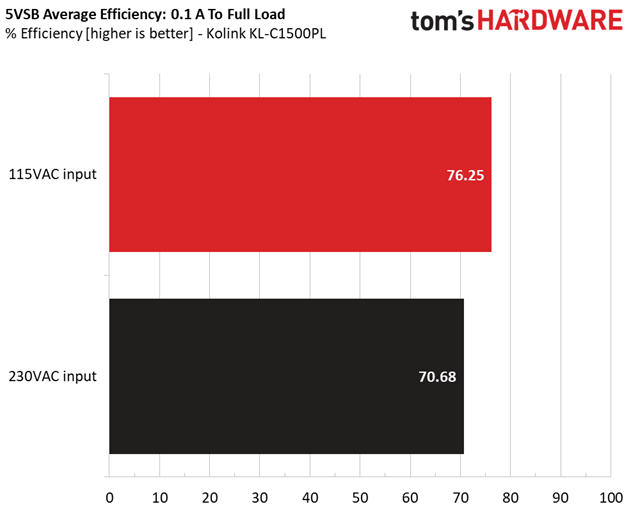
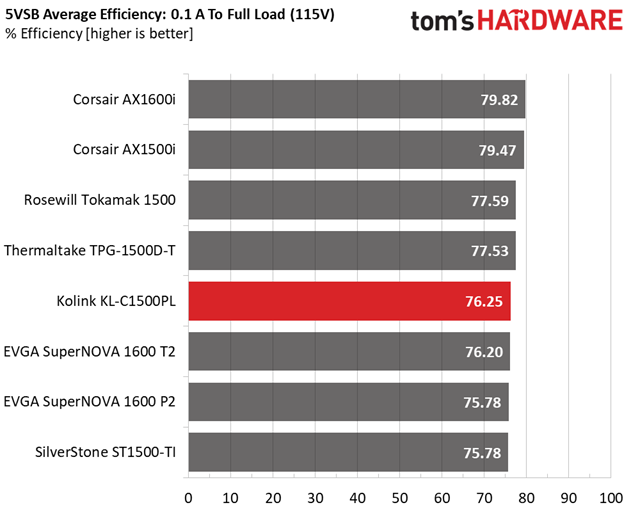
The 5VSB circuit registers high efficiency levels with 115V. However, the efficiency drop is notable with 230V input.
Power Consumption In Idle And Standby
In the table below, you'll find the power consumption and voltage values of all rails (except -12V) when the PSU is idle (powered on, but without any load on its rails), and the power consumption when the PSU is in standby mode (without any load, at 5VSB).
| Mode | 12V | 5V | 3.3V | 5VSB | Watts | PF/AC Volts |
|---|---|---|---|---|---|---|
| Idle | 12.215V | 5.092V | 3.341V | 5.140V | 6.920 | 0.297 |
| 116.0V | ||||||
| Standby | 0.120 | 0.006 | ||||
| 115.3V |
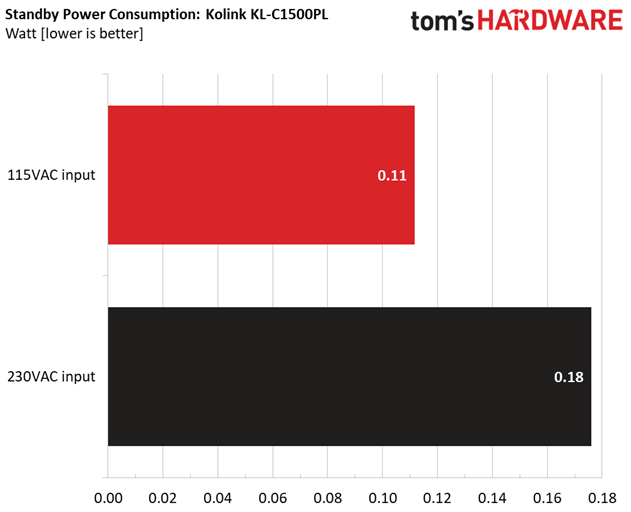
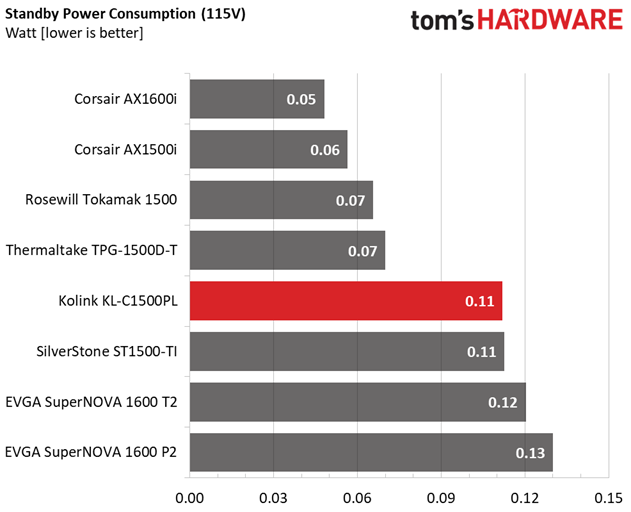
The KL-C1500PL's power consumption in standby is fairly average for this wattage category, and with 230V it stays below 0.2W.
Fan RPM, Delta Temperature, And Output Noise
Our mixed noise testing is described in detail here.
The first chart below illustrates the cooling fan's speed (in RPM), and the delta between input and output temperature.The results were obtained at 37°C (98.6°F) to 48°C (118.4°F) ambient temperature.
The next chart shows the cooling fan's speed (again, in RPM) and output noise. We measured acoustics from one meter away, inside a hemi-anechoic chamber. Background noise inside the chamber was below 6 dB(A) during testing (it's actually much lower, but our sound meter’s microphone hits its floor), and the results were obtained with the PSU operating at 37°C (98.6°F) to 48°C (118.4°F) ambient temperature.
The following graph illustrates the fan's output noise over the PSU's operating range. The same conditions of the above graph apply to our measurements, though the ambient temperature was between 30°C (86°F) to 32°C (89.6°F).
Passive operation lasts up until around 210W load, with the PSU's fan staying mostly below 30 dB(A) with up to 690W. Afterwards, the fan quickly increases its speed and noise output. With more than 1kW load, the PSU gets a lot noisier (>45 dB[A]).
MORE: Best Power Supplies
MORE: How We Test Power Supplies
MORE: All Power Supply Content
Current page: Efficiency, Temperature & Noise
Prev Page Load Regulation, Hold-Up Time & Inrush Current Next Page Protection Features
Aris Mpitziopoulos is a contributing editor at Tom's Hardware, covering PSUs.
-
ozicom "The problem we see is that all eight-pin connectors have the same pattern, making it possible to accidentally connect an EPS cable to a PCIe socket and vice versa." Well I had a fully modular PSU in past and you can't connect eight pin of EPS to PCIe because the sockets may look same but they're not. If you look closer on top left two sockets of black and blue eight pins the notches are not same so you can't connect it. But if you tried and connect it it's a problem of course.Reply
